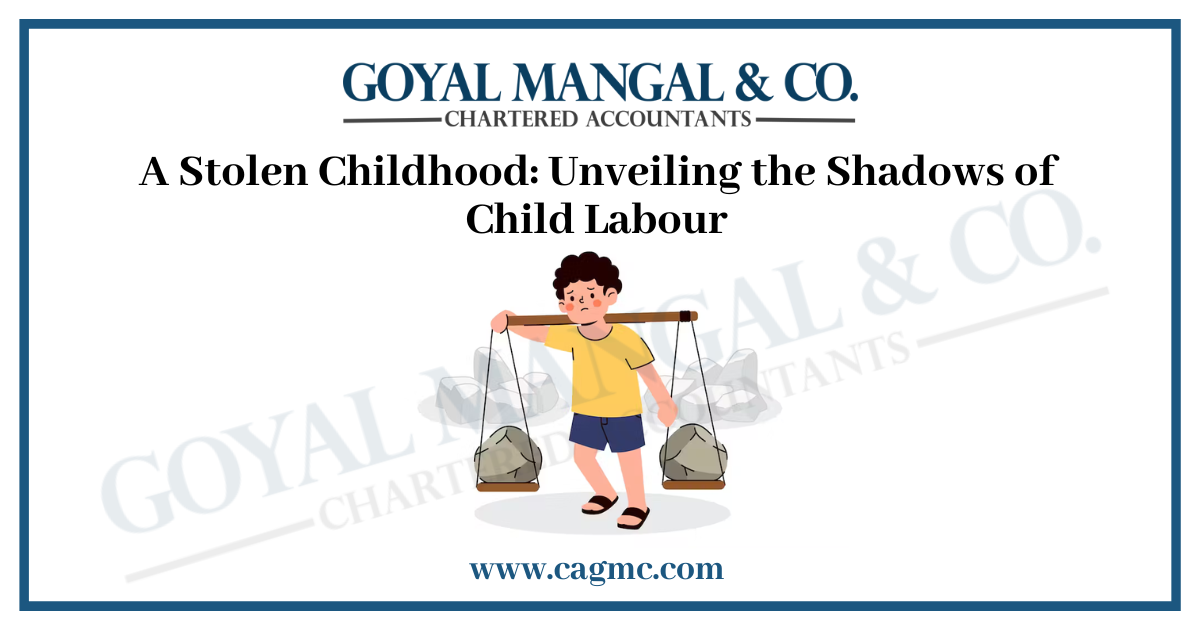
Child Labour is the major concern in India, as it takes away the innocence of childhood and leaving scars upon the hearts of millions. Child labour is an insidious crime that troubles at the core of society, constantly robs young souls of their rightful joys and aspirations. It is crucial to investigate this matter and reveals the darkest truth that lost innocence and dreams shattered. This article provides detailed insights into the Child labour laws and regulations to protect children’s rights and prevent Child labour in India.
What is Child labour?
Child labour is when children are made to do work that helps the economy, whether it’s part-time or full-time. Children who do this often don’t get to do normal things like go to school and left with physical and mental scars.
Poverty, a lack of good schools and education, and the growth of the underground economy are the main things that cause children to work.
When a child is forced to do work, he or she is deprived from the safe and healthy environment to grow up. He or she also often goes through physical and mental stress that can leave permanent scars. The child doesn’t get an education and abused in different ways, which keeps him or her from becoming a happy, healthy adult.
What activities constitute Child labour?
The following activities constitute Child labour:
- All kinds of slavery and practices are like slavery, such as selling or trading children, making people work for debt, and making people work against their will.
- It also refers to the forced or forced enlistment of children to fight in a war.
- When a child is used for prostitution, to make pornographic films, or to perform pornographic acts.
- Using a child for illegal activities, especially for making and selling drugs, is against international agreements.
- It includes work that, because of what it is or how it is done, is likely to hurt children’s health, safety, or values.
Activities not included in Child labour
It does not include the following work:
- Helping their parents around the house, working in a family business, or making extra money outside of school hours and on school breaks. People do think that these things help children to grow and learn more.
- Participation in work by children or adolescents that does not affect their health and personal development or interfere with their education is generally regarded as a positive thing.
The primary goal of the Child Labour Regulation and Prevention Act, 1986
The primary goal of the Child Labour Regulation and Prevention Act, 1986 is to control the employment of children in certain occupations. Along with that to prohibit the employment of children in certain hazardous occupations and processes. The act protects children from exploitation and to make sure that they have access to education and safe & healthy childhood.
The Act aims to protect the rights of children and make sure that they are not forced to work in hazardous and exploitative conditions. It recognizes the essence of education and leads to create a framework in that children can receive an education.
Hours of Work
The Hours of Work as per the Child Labour prohibition and Regulation Act, 1986 are:
- No child or teen should be forced to work between the hours of 7 PM and 8 AM.
- No business can make a teenager work more than the number of hours that are set for the business or group of businesses.
- Teenagers shouldn’t be able to work more than 5 hours a day.
- No child or teen should be allowed or forced to work extra hours.
Intervals for rest and meals
The length of work each day can’t be more than 3 hours, and for a teenager can’t work for more than 3 hours without taking at least 1 hour off.
Maintenance of Register
Every owner or manager of a place where children work or are allowed to work must keep a register that an inspector can look at any time during working hours or when work is being done in that place. The register must include:
- The name and date of birth of every child so employed or allowed to work.
- The hours and periods of work of any such child and the breaks to which he is entitled.
- The kind of work the child is doing.
Penalty
Those who don’t follow or breaks any other part of this law, or the rules made under it will be punished with imprisonment for up to one month, a fine of up to 10,000 rupees, or both.
The Child Labour Regulation and Prevention Act 1986 Prohibition
Prohibitions as per Child Labour Regulation and Prevention Act 1986 are:
- Employing someone younger than 14 is against the law.
- It prevents anyone younger than 14 from engaging in certain hazardous occupations or tasks.
- It prohibits the use of minors in certain occupations and processes that are dangerous to their physical and mental well-being.
- Employers that violate the Act are subject to severe penalties, including fines and jail time, and the Act regulates the industries in which minors are allowed to work.
- The Act does not apply to households or educational institutions.
- Fine and a prison sentence are possible penalties for breaking the Act.
Takeaway
The 1986 Child Labour (Prohibition and Regulation) Act prohibits children from working in dangerous jobs. The Child Labour Regulation and Prevention Act 1986 sets a 14-year employment requirement. It reduced child labour in India. It has decreased workplace hazards and exploitation of child workers by setting maximum work hours and other rules.
If an employer violates the Act by employing a youngster, they may be fined or imprisoned. Although the Act has reduced the number of child labours, this evil is still lingering in our society due to socio-economic issues like poverty and illiteracy.
Justice Subba Rao, the former Chief Justice of India, rightly said, “Social justice must start with the child. A tender plant has little chance of becoming a powerful and useful tree unless it is properly managed and nourished. Thus, justice should prioritize child well-being and for this child labour must be stopped.


